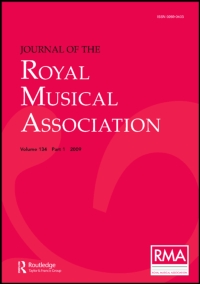Article contents
On the Musical Introductions Found in Certain Metrical Psalters
Published online by Cambridge University Press: 01 January 2020
Extract
These Introductions, Directions, or Principles, as they were variously styled, contain what we should now term the Rudiments of Music, or at all events, as much of them as is needed for those who wish to sing a simple melody. They have an interest peculiarly their own, as illustrating the efforts made by the pioneers of congregational psalmody to secure an intelligent, as well as a general participation in its rendering.
- Type
- Research Article
- Information
- Copyright
- Copyright © Royal Musical Association, 1900
References
∗ About ninety-five are given in the body of the book, the gaps being filled up by an “Addition,” which also contains a few psalms in duplicate versified by different hands I am much indebted to Professor York Powell, Librarian of Christ Church, for allowing me to examine these two unique and priceless treasures.Google Scholar
† Hawkins asserts that the “Short Introduction” did not re-appear after 1577. It certainly is given in the 8vo edition of 1581, though not in the 4to edition of the same date.Google Scholar
∗ Mr. Wooldridge, in his interesting article on Psalters in Grove's Dictionary, states that the edition of 1607 has musical instructions, and that some solfeggio-names are added under some of the notes. The Bodleian copy of this edition, a copy in my own library, and two others of different sizes in the British Museum have been collated, but in neither case is there any prefatory musical matter or letter-notes. It does not follow that Mr. Wooldridge has made a mistake; for there is often great irregularity in the making up of books of this period, and I have no doubt he has seen a copy having the contents he describes.Google Scholar
† I wish to express my gratitude to Mr. Alfred Littleton for placing his copy of this rare book at my entire disposal. Though so exceedingly scarce, there appear to have been two different title-pages, one having the name of Michel du Boys with the device of an open book within a border of branches, the other (as in Mr. Littleton's copy) having the name of Davantes and the device of the Virgula Divina with mottoes in Hebrew and Greek, “Lift up on us the light of Thy countenance, O Lord,” and “Knowledge maketh rich.”Google Scholar
∗ A reference to the Part-books of contemporary Madrigals shows that words were generally printed without separating the component syllables, provided the music had a note for each syllable Hyphens are only used when several notes go to one syllable, and when a word is divided between the end of one line and the beginning of the next.Google Scholar
∗ This use of the word “phonask” for an unaccompanied single-vocal part is fortunately as rare as it is unclassical. I presume he derived it, not from ![]() but from
but from ![]() , an exercising of the voice in declamation. The use of “symphonask” for part-singing is even less justifiable. We may well congratulate ourselves that both terms are obsoleteGoogle Scholar
, an exercising of the voice in declamation. The use of “symphonask” for part-singing is even less justifiable. We may well congratulate ourselves that both terms are obsoleteGoogle Scholar
∗ Dr. McNaught also quotes from this book in his admirable paper on “The history and use of the sol-fa syllables,” read before the Musical Association, January, 1893.Google Scholar
∗ The most curious attempt to give a metronomic value to notes which I have ever met is quoted in an article by J. F. R. Stainer, in the Musical Times of October, 1899, from an old book (about 1700) giving a description of “musical birds in this kingdom” and showing how they can be taught tunes by means of a small flageolet. It is as follows:—“Two minims make a semibrief, and a semibrief is the length of the natural song of the wild chaffinch. I except the Essex chaffinch which is longer than ours are in these parts. And 28 semibriefs is a minute of an hour.” As this author almost always uses a crotchet for each beat this would make ![]() .Google Scholar
.Google Scholar
† About thirteen copies are known to exist, one being in the library of Magdalen College, Oxford.Google Scholar
∗ Take, for example, the two deeply interesting Wesleyan books “Sacred Melody” (? 1761) and “Sacred Harmony” (? 1789).Google Scholar
- 1
- Cited by


